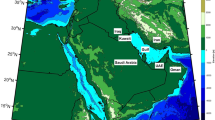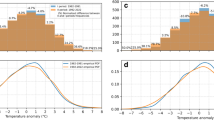Abstract
The phase shift between changes in the global surface temperature Tg and atmospheric CO2 content \({{q}_{{{\text{C}}{{{\text{O}}}_{2}}}}}\) has been shown earlier not to characterize causal relationships in the Earth system in the general case. Specifically, the sign of this phase shift under nongreenhouse radiative forcing changes depends on the time scale of this forcing. This paper analyzes the phase shift between changes in the global surface temperature Tg and the atmospheric CO2 content \({{q}_{{{\text{C}}{{{\text{O}}}_{2}}}}}\) under synchronous external emissions of carbon dioxide and methane into the atmosphere on the basis of numerical experiments with the IAP RAS climatic model and a conceptual climate model with carbon cycle. For a sufficiently large time scale of external forcing, the changes in \({{q}_{{{\text{C}}{{{\text{O}}}_{2}}}}}\) lag relative to the corresponding changes in Tg.



Similar content being viewed by others
REFERENCES
IPCC, 2013: Climate Change 2013: The Physical Science Basis. Contribution of Working Group I to the Fifth Assessment Report of the Intergovernmental Panel on Climate Change, Ed. by T. F. Stocker, D. Qin, G.-K. Plattner, (Cambridge Univ. Press, Cambridge, 2013).
J. Lean and D. Rind, “How natural and anthropogenic influences alter global and regional surface temperatures: 1889 to 2006,” Geophys. Res. Lett. 35 (18), L18701 (2008).
I. I. Mokhov and D. A. Smirnov, “Empirical estimates of the influence of natural and anthropogenic factors on the global surface temperature,” Dokl. Earth Sci. 427 (1), 798–803 (2009).
D. A. Smirnov and I. I. Mokhov, “From Granger causality to long-term causality: Application to climatic data,” Phys. Rev. E 80 (1), 016208 (2009).
C. D. Schonwiese, A. Walter, and S. Brinckmann, “Statistical assessments of anthropogenic and natural global climate forcing. An update,” Meteorol. Z. 19 (1), 3–10 (2010).
I. I. Mokhov, D. A. Smirnov, and A. A. Karpenko, “Assessments of the relationship of changes of the global surface air temperature with different natural and anthropogenic factors based on observations,” Dokl. Earth Sci. 443 (1), 381–387 (2012).
I. I. Mokhov and D. A. Smirnov, “Estimating the contributions of the Atlantic multidecadal oscillation and variations in the atmospheric concentration of greenhouse gases to surface air temperature trends from observations,” Dokl. Earth Sci. 480 (1), 602–606 (2018).
G. Hegerl, K. Hasselmann, U. Cubasch, J. Mitchell, E. Roeckner, R. Voss, and J. Waszkewitz, “Multi-fingerprint detection and attribution analysis of greenhouse gas, greenhouse gas-plus-aerosol and solar forced climate change,” Clim. Dyn. 13, 613–634 (1997).
P. Stott, S. Tett, G. Jones, M. Allen, W. Ingram, and J. Mitchell, “Attribution of twentieth century temperature change to natural and anthropogenic causes,” Clim. Dyn. 17 (1), 1–21 (2001).
D. Stone, M. Allen, F. Selten, M. Kliphuis, and P. Stott, “The detection and attribution of climate change using an ensemble of opportunity,” J. Clim. 20 (3), 504–516 (2007).
D. Stone, M. Allen, P. Stott, P. Pall, S. K. Min, T. Nozawa, and S. Yukimoto, “The detection and attribution of human influence on climate,” Annu. Rev. Energy Resour. 34, 1–16 (2009).
K. Sedlacek and R. Knutti, “Evidence for external forcing on 20th-century climate from combined ocean atmosphere warming patterns,” Geophys. Res. Lett. 39 (20), L20708 (2012).
G. Jones, P. Stott, and N. Christidis, “Attribution of observed historical near-surface temperature variations to anthropogenic and natural causes using CMIP5 simulations,” J. Geophys. Res.: Atmos. 118 (10), 4001–4024 (2013).
A. Ribes and L. Terray, “Application of regularised optimal fingerprint analysis for attribution. Part II: Application to global near-surface temperature,” Clim. Dyn. 41 (11–12), 2837–2853 (2013).
E. Monnin, A. Indermohle, A. Dallenbach, J. Flockiger, B. Stauffer, T. Stocker, D. Raynaud, and J. M. Barnola, “Atmospheric CO2 concentrations over the last glacial termination,” Science 291 (5501), 112–114 (2001).
I. I. Mokhov, V. A. Bezverkhny, and A. A. Karpenko, “Diagnosis of relative variations in atmospheric greenhouse gas contents and temperature from Vostok Antarctic ice-core paleoreconstructions,” Izv., Atmos. Ocean. Phys. 41 (5), 523–536 (2005a).
I. I. Mokhov, V. A. Bezverkhny, and A. A. Karpenko, “Mutual changes in the temperature regime and content of greenhouse gases in the atmosphere from paleoreconstructions for the last 800 ka,” in Extreme Natural Phenomena and Catastrophes, Vol. 1: Assessment and Ways to Mitigating the Adverse Effects of Extreme Natural Phenomena, Ed. by A. O. Gliko (IFZ RAN, Moscow, 2010), pp. 312–319 [in Russian].
B. Bereiter, D. Luthi, M. Siegrista, S. Schupbach, T. Stocker, and H. Fischer, “Mode change of millennial CO2 variability during the last glacial cycle associated with a bipolar marine carbon seesaw,” Proc. Natl. Acad. Sci. U.S.A. 109 (25), 9755–9760 (2012).
O. Humlum, K. Stordahl, and J. E. Solheim, “The phase relation between atmospheric carbon dioxide and global temperature,” Glob. Planet. Change 100, 51–69 (2013).
J. Quinn, Global Warming, Geophysical Counterpoints to the Enhanced Greenhouse Theory (Dorrance Publ., Pittsburgh, 2010).
K. E. Muryshev, A. V. Eliseev, I. I. Mokhov, and A. V. Timazhev, “A lag between temperature and atmospheric CO2 concentration based on a simple coupled model of climate and the carbon cycle,” Dokl. Earth Sci. 463 (2), 863–867 (2015).
K. E. Muryshev, A. V. Eliseev, I. I. Mokhov, and A. V. Timazhev, “Lead–lag relationships between global mean temperature and the atmospheric CO2 content in dependence of the type and time scale of the forcing,” Glob. Planet. Change 148, 29–41 (2017).
K. E. Muryshev, A. V. Timazhev, and M. V. Dembitskaya, “Time lag between changes in global temperature and atmospheric content of carbon dioxide under non-greenhouse external forcing of the climate system,” Fundam. Prikl. Klimatol., No. 3, 84–102 (2017).
I. I. Mokhov, Diagnostics of the Climate System Structure (Gidrometeoizdat, St. Petersburg, 1993) [in Russian].
I. I. Mokhov, P. F. Demchenko, A. V. Eliseev, V. Ch. Khon, and D. V. Khvorost’yanov, “Estimation of global and regional climate changes during the 19th–21st centuries on the basis of the IAP RAS model with consideration for anthropogenic forcing,” Izv., Atmos. Ocean. Phys. 38 (5), 555–568 (2002).
I. I. Mokhov, A. V. Eliseev, P. F. Demchenko, V. Ch. Khon, M. G. Akperov, M. M. Arzhanov, A. A. Karpenko, V. A. Tikhonov, A. V. Chernokulsky, and E. V. Sigaeva, “Climate changes and their assessment based on the IAP RAS global model simulations,” Dokl. Earth Sci. 402 (4), 591–595 (2005).
A. V. Eliseev, “Estimation of changes in characteristics of the climate and carbon cycle in the 21st century accounting for the uncertainty of terrestrial biota parameter values,” Izv., Atmos. Ocean. Phys. 47 (2), 131–153 (2011).
A. V. Eliseev and I. I. Mokhov, “Uncertainty of climate response to natural and anthropogenic forcings due to different land use scenarios,” Adv. Atmos. Sci. 28 (5), 1215–1232 (2011).
I. I. Mokhov and A. V. Eliseev, “Modeling of global climate variations in the 20th–23rd centuries with new RCP scenarios of anthropogenic forcing,” Dokl. Earth Sci. 443 (2), 532–536 (2012).
A. V. Eliseev and D. E. Sergeev, “Impact of subgrid-scale vegetation heterogeneity on the simulation of carbon-cycle characteristics,” Izv., Atmos. Ocean. Phys. 50 (3), 225–235 (2014).
A. V. Eliseev, I. I. Mokhov, and A. V. Chernokulsky, “Influence of ground and peat fires on CO2 emissions into the atmosphere,” Dokl. Earth Sci. 459 (2), 1565–1569 (2014).
A. Eliseev, I. Mokhov, and A. Chernokulsky, “An ensemble approach to simulate CO2 emissions from natural fires,” Biogeosciences 11 (12), 3205–3223 (2014).
A. Eliseev, “Impact of tropospheric sulphate aerosols on the terrestrial carbon cycle,” Glob. Planet. Change 124, 30–40 (2015).
A. V. Eliseev, “Influence of sulfur compounds on the terrestrial carbon cycle,” Izv., Atmos. Ocean. Phys. 51 (6), 599–608 (2015).
M. M. Arzhanov, A. V. Eliseev, P. F. Demchenko, I. I. Mokhov, and V. Ch. Khon, “Simulation of thermal and hydrological regimes of Siberian river watersheds under permafrost conditions from reanalysis data,” Izv., Atmos. Ocean. Phys. 44 (1), 83–89 (2008).
M. M. Arzhanov, A. V. Eliseev, and I. I. Mokhov, “Impact of climate changes over the extratropical land on permafrost dynamics under RCP scenarios in the 21st century as simulated by the IAP RAS climate model,” Russ. Meteorol. Hydrol. 38 (7), 456–464 (2013).
A. V. Eliseev, M. M. Arzhanov, P. F. Demchenko, and I. I. Mokhov, “Changes in climatic characteristics of Northern Hemisphere extratropical land in the 21st century: Assessments with the IAP RAS climate model,” Izv., Atmos. Ocean. Phys. 45 (3), 271–283 (2009).
A. V. Eliseev, I. I. Mokhov, M. M. Arzhanov, P. F. Demchenko, and S. N. Denisov, “Interaction of the methane cycle and processes in wetland ecosystems in a climate model of intermediate complexity,” 44 (2), 139–152 (2008).
S. N. Denisov, M. M. Arzhanov, A. V. Eliseev, and I. I. Mokhov, “Sensitivity of methane emissions from Western Siberian wetlands to climate changes: Multi-model estimations,” Opt. Atmos. Okeana 24 (4), 319–322 (2011).
S. N. Denisov, A. V. Eliseev, and I. I. Mokhov, “Climate change in IAP RAS global model taking account of interaction with methane cycle under anthropogenic scenarios of RCP family,” Russ. Meteorol. Hydrol. 38 (11), 741–749 (2013).
T. J. Osborn and T. M. L. Wigley, “A simple model for estimating methane concentration and lifetime variations,” Clim. Dyn. 9, 181–193 (1994).
M. Andreae, C. Jones, and P. Cox, “Strong present-day aerosol cooling implies a hot future,” Nature 435 (7046), 1187–1190 (2005).
T. Masters and R. Benestad, “Comment on "The phase relation between atmospheric carbon dioxide and global temperature”," Glob. Planet. Change 106, 141–142 (2013).
G. Myhre, E. J. Highwood, K. P. Shine, and F. Stordal, “New estimates of radiative forcing due to well mixed greenhouse gases,” Geophys. Res. Lett. 25, 2715–2718 (1998).
N. Gedney, P. M. Cox, and C. Huntingford, “Climate feedback from wetland methane emissions,” Geophys. Res. Lett. 31, L2050 (2004).
FUNDING
This study was supported by the Russian Foundation for Basic Research, project no. 18-05-00087, and the Fund for State Support of Kazan (Privolzhskii) Federal University aimed at improving the competitive capability among leading scientific and educational centers in the world, using the results obtained in the framework of the RAS Program “Climate Change: Causes, Risks, Consequences, Problems of Adaptation and Regulation”. Estimates of phase shifts in climatic processes were also carried out within the framework of the RSF project (no. 19-17-0240).
Author information
Authors and Affiliations
Corresponding author
Additional information
Translated by V. Arutyunyan
Rights and permissions
About this article
Cite this article
Muryshev, K.E., Eliseev, A.V., Denisov, S.N. et al. Phase Shift between Changes in Global Temperature and Atmospheric CO2 Content under External Emissions of Greenhouse Gases into the Atmosphere. Izv. Atmos. Ocean. Phys. 55, 235–241 (2019). https://doi.org/10.1134/S0001433819030046
Received:
Revised:
Accepted:
Published:
Issue Date:
DOI: https://doi.org/10.1134/S0001433819030046




